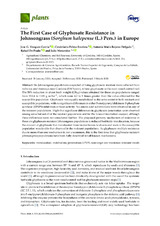The First Case of Glyphosate Resistance in Johnsongrass (Sorghum halepense (L.) Pers.) in Europe

View/
Author
Vázquez-García, José Guadalupe
Palma-Bautista, Candelario
Rojano Delgado, Antonia M.
Prado Amián, Rafael de
Menéndez Calle, Julio
Publisher
MDPIDate
2020Subject
TranslocationMetabolism
Penetration
EPSPS
Non-target site resistance
Resistant weeds
METS:
Mostrar el registro METSPREMIS:
Mostrar el registro PREMISMetadata
Show full item recordAbstract
Six Johnsongrass populations suspected of being glyphosate resistant were collected from railways and freeways near Cordoba (SW Spain), where glyphosate is the main weed control tool. The 50% reduction in shoot fresh weight (GR50) values obtained for these six populations ranged from 550.4 to 1169 g ae ha−1, which were 4.2 to 9 times greater than the value obtained for the susceptible population. Glyphosate was equally metabolized to the same extent in both resistant and susceptible populations, with no significant differences in either 5-enolpyruvylshikimate-3-phosphate synthase (EPSPS) inhibition or basal activity. No amino acid substitutions were observed in any of the resistant populations. Slight but significant differences in glyphosate penetration were observed among some but not all of the resistant populations and for the times of incubation assayed, although these differences were not considered further. The proposed primary mechanism of resistance in these six glyphosate-resistant Johnsongrass populations is reduced herbicide translocation, because the amount of glyphosate that translocated from treated leaves to shoots and roots in the susceptible population was double that observed in the resistant populations. As glyphosate multiple resistance due to more than one mechanism is not uncommon, this is the first time that glyphosate-resistant Johnsongrass populations have been fully described for all known mechanisms.
